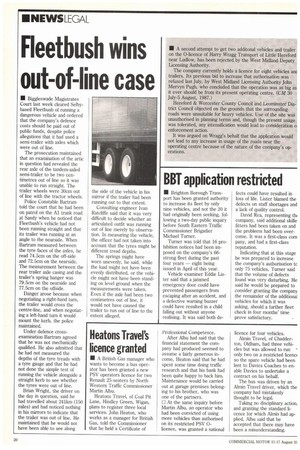Fleetbush wins out-of-line case
Page 18

If you've noticed an error in this article please click here to report it so we can fix it.
• Biggleswade Magistrates Court last week cleared Selbybased Fleetbush of running a dangerous vehicle and ordered that the company's defence costs should be paid out of public funds, despite police allegations that it had used a semi-trailer with axles which were out of line.
The prosecution maintained that an examination of the artic in question had revealed the rear axle of the tandem-aided semi-trailer to be two centimetres out of line so it was unable to run straight. The trailer wheels were 30cm out of line with the tractor wheels.
Police Constable Bartram told the court that he had been on patrol on the Al trunk road at Sandy when he noticed that Fleetbush's vehicle had not been running straight and that its trailer was running at an angle to the nearside. When Bartram measured between the tyre faces of the axles, he read 74.5cm on the off-side and 72.5cm on the nearside. The measurement between the rear trailer axle casing and the trailer's spring hanger was 79.5crn on the nearside and 77.5cm on the offside.
Danger arose because when negotiating a right-hand turn, the trailer would cross the centre-line, and when negotiating a left-hand turn it would mount the kerb, the police maintained.
Under defence crossexamination Bartram agreed that he was not mechanically qualified. He also admitted that he had not measured the depths of the tyre treads with a tyre gauge and that he had not done the simple test of running the vehicle alongside a straight kerb to see whether the tyres were out of line.
Brian Wright, the driver on the day in question, said he had travelled about 2411cm (150 miles) and had noticed nothing in his mirrors to indicate that the trailer was out of line. He maintained that he would not have been able to see along the side of the vehicle in his mirror if the trailer had been running out to that extent.
Consulting engineer Ivan Ratcliffe said that it was very difficult to decide whether an articulated outfit was running out of line merely by observation. In measuring the vehicle, the officer had not taken into account that the tyres might be different tread depths.
The springs might have worn unevenly, he said, while the load might not have been evenly distributed, or the vehicle might not have been standing on level ground when the measurements were taken. Even if the axle had been two centimetres out of line, it would not have caused the trailer to run out of line to the extent alleged.












































